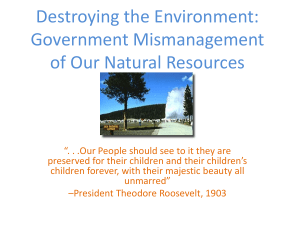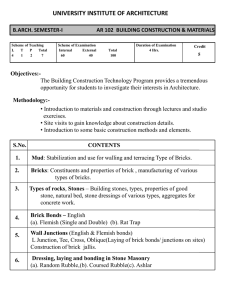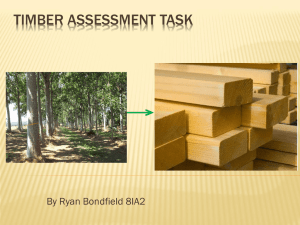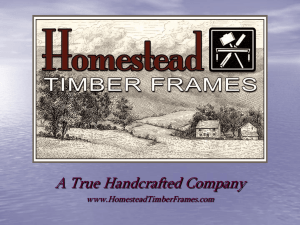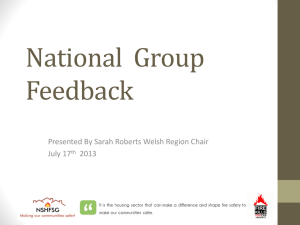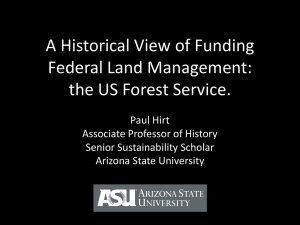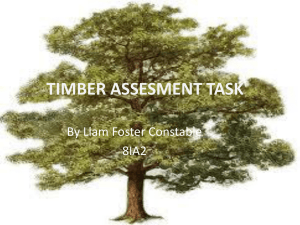Casey Grant, National Fire Protection Research Foundation, USA
advertisement
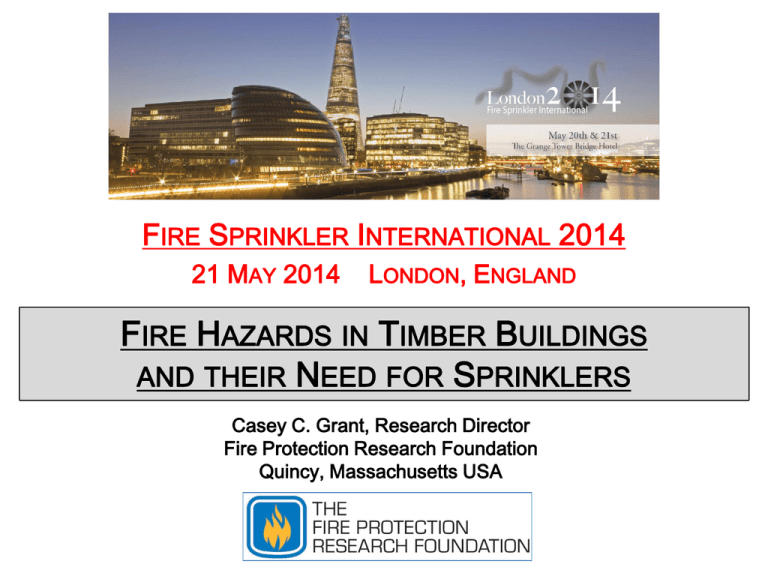
FIRE SPRINKLER INTERNATIONAL 2014 21 MAY 2014 LONDON, ENGLAND FIRE HAZARDS IN TIMBER BUILDINGS AND THEIR NEED FOR SPRINKLERS Casey C. Grant, Research Director Fire Protection Research Foundation Quincy, Massachusetts USA Fire Hazards in Timber Buildings and their Need for Sprinklers AGENDA 1) Overview and Background 2) Timber Building Construction 3) Building Regulations for Timber 4) Timber Fire Performance 5) Knowledge Gaps & Future Direction 1) Overview and Background “FIRE HAZARDS IN TIMBER BUILDINGS AND THEIR NEED FOR SPRINKLERS” • Focus of this presentation: o Fire hazards… o Timber buildings… o Tall wood buildings… • Key focus: “Fire Safety Challenges of Tall Wood Buildings” • FPRF Report, Dec 2013 • Report Author: Arup • Phase 1 Study • Available on FPRF Website www.nfpa.org/foundation 1) Overview and Background FPRF PROJECT BACKGROUND • Recent architectural trends include design and construction of increasingly tall buildings with structural components • Using components of laminated wood referred to by names such as: • • • cross laminated timber (CLT), laminated strand lumber (LSL) glued laminated timber (Glulam) • Construction currently underway on buildings up to 10 stories in Australia, Austria, Canada and Norway • Motivation includes sustainability and green approach (use of renewable construction materials) • Questions on claims of safety exceeding other construction 1) Overview and Background FPRF PROJECT ORIGIN AND DEVELOPMENT • Need exists to clarify building performance under credible fire scenarios. • Questions on characteristics (e.g., fire service operations, interior/exterior flame spread, structural stability, fire exposure hazard, etc) • Project funded by PIRG – Property Insurance Research Group • Project contractor was Arup • Project started earlier in 2013 • Phase 1 completed December 2013 1) Overview and Background FPRF PROJECT SCOPE AND TASKS • Focus on buildings 6 stories and greater • Intent is to consider fire protection features that are functioning, or are partially or fully impaired • Objectives (overall): • Characterize the fire performance of tall wooden structures. • Define the necessary design and material requirements to achieve a level of safety and property protection equal to or above steel structures. • Communicate the results to serve as a guide for architects, engineers, and code officials. • Phase 1 Task 1: Literature Review • Phase 1 Task 2: Gap Analysis 1) Overview and Background REPORT: INTRODUCTION • • • • • • 1.1) Phase 1 of the Fire Safety Study 1.2) Background 1.3) Context: Visions of Tall Timber 1.4) Principles of Fire Safety 1.5) Timber Building Fundamentals 1.6) Timber Fire Fundamentals 1) Overview and Background REPORT: TASK 1 LITERATURE REVIEW • 2.1) Overview • 2.2) Testing Data on Timber Structural Components in Fire • 2.3) Ongoing Research Studies • 2.4) Review of Fire Incidents in Timber Structures • 2.5) Review of Existing Design Guidelines • 2.6) Global Case Studies of High-Rise / Tall Timber Framed Buildings 1) Overview and Background REPORT: TASK 2 GAP ANALYSIS • 3.1) Overview • 3.2) Structural and NonStructural Component and Sub-System Fire Tests • 3.3) Compartment Fire Dynamics • 3.4) Environment • 3.5) Economics • 3.6) Society • 3.7) Prioritization 1) Overview and Background SUPPORTING INFO: TALL BUILDING FIRE PROTECTION • Report: “High Rise Building Fires” • Fire Stats on U.S. High Rise Buildings • For 2007 through 2011 1) Overview and Background SUPPORTING INFO: TALL BUILDING FIRE PROTECTION • Annual average: 15,400 fires; 46 civilian fatalities; 530 civilian injuries; $219M property damage • Risk is lower in high rise buildings • Reason: higher levels of built-in fire protection (e.g., fire resistive construction, sprinklers) Fire Hazards in Timber Buildings and their Need for Sprinklers AGENDA 1) Overview and Background 2) Timber Building Construction 3) Building Regulations for Timber 4) Timber Fire Performance 5) Knowledge Gaps & Future Direction 2) Timber Building Construction EXAMPLES OF FEATURES AND CHARACTERISTICS • Heavy timber frame products - Engineered wood products Glue laminated wood (Glulam) Laminated Veneer Lumber (LVL) Cross Laminated Timber (CLT) 2) Timber Building Construction EXAMPLES OF FEATURES AND CHARACTERISTICS • Heavy timber frame products - Composite wood products Post-tensioned timber Timber-concrete composite 2) Timber Building Construction EXAMPLES OF FEATURES AND CHARACTERISTICS • Heavy timber frame construction - Panelized construction 2) Timber Building Construction EXAMPLES OF EXISTING TIMBER BUILDINGS • Historical examples Yiangxian Pagoda, China, 1056 Urnes Stakirke, Norway, 1132 Leckie Building, Vancouver, Canada, 1908 2) Timber Building Construction EXAMPLES OF EXISTING TIMBER BUILDINGS • Contemporary examples - Post and beam construction Life Cycle Tower One Austria, 2012 Bullitt Center Wood Innovation Design Centre Seattle, WA 2013 Prince George, Canada, 2014 2) Timber Building Construction EXAMPLES OF EXISTING TIMBER BUILDINGS • Contemporary examples - Panelized construction Stadthaus London, UK 2009 Via Cenni Milan, Italy 2013 Forte Building Melbourne, Australia 2013 2) Timber Building Construction FEASIBILITY EXAMPLES OF TALL TIMBER BUILDINGS 40-story office building CEI Architecture, 2013 Timber Tower SOM, 2013 30-story high-rise Michael Green Architecture, 2012 Fire Hazards in Timber Buildings and their Need for Sprinklers AGENDA 1) Overview and Background 2) Timber Building Construction 3) Building Regulations for Timber 4) Timber Fire Performance 5) Knowledge Gaps & Future Direction 3) Building Regulations for Timber INTERNATIONAL REGULATIONS Maximum # of Stories Country Applicable Building Code Sprinklered Unsprinklered Australia 2013 Building Code of Australia (BCA) 3 3 Austria Austrian Building Codes 8 (*72 feet) 3 Canada 2010 National Building Code of Canada (NBCC) 4 3 Germany 2012 Federal Building Code 8 (*59 feet) 3 Sweden 2013 Planning and Building Act 8 2 United Kingdom 2010 Building Regulations 5** 4** * Indicates a height limit in addition to a maximum story limit 3) Building Regulations for Timber U.S. REGULATIONS Maximum # of Stories Applicable Building Code Sprinklered Unsprinklered 2013 International Building Code (IBC) 5* 4* 2012 National Fire Protection Association (NFPA) 5000 6* 5* * Number of heavy timber stories permitted Fire Hazards in Timber Buildings and their Need for Sprinklers AGENDA 1) Overview and Background 2) Timber Building Construction 3) Building Regulations for Timber 4) Timber Fire Performance 5) Knowledge Gaps & Future Direction 4) Timber Fire Performance CHARRING • Well understood… • Predictable… • ~0.7mm/min (0.03 in/min) 4) Timber Fire Performance EXAMPLES FROM LITERATURE REVIEW • Timber Frame 2000 (TF 2000) - Cardington, UK, 1999 - Fire resistance mid-rise timber building 4) Timber Fire Performance EXAMPLES FROM LITERATURE REVIEW • Natural fire testing, Frangi and Fontana, 2005 - CLT structure - Sprinklered vs. non-sprinklered - Exposed wood vs. gypsum lining Sprinkler protection Gypsum board lining Exposed CLT 4) Timber Fire Performance EXAMPLES FROM LITERATURE REVIEW • Light timber assemblies - Improved fire resistance with gypsum board layers and thickness - Design equations (Just, Schmid and Konig, 2010) 4) Timber Fire Performance EXAMPLES FROM LITERATURE REVIEW • CLT assemblies (Osborne, Dagenais, Benichou, 2012) - Charring rate consistent with wood (~0.7 mm/min [0.03 in/min]) - Predictable behavior - Improved performance with gypsum board protection 4) Timber Fire Performance EXAMPLES FROM LITERATURE REVIEW • Timber composite assemblies (O’Neill, 2012) - Fire performance based on testing - Up to 2-hour ratings for assemblies 4) Timber Fire Performance EXAMPLES FROM LITERATURE REVIEW • Environmental impact of fire protection (Wieczorek, Ditch & Bill 2010) - Tests demonstrate the positive impact of sprinklers: o Reduction in greenhouse gas emissions by 97.8% o Reduction in water usage between 50% and 91% o Significant improvement in water runoff quality o Reduction in fire-damaged contents Fire Hazards in Timber Buildings and their Need for Sprinklers AGENDA 1) Overview and Background 2) Timber Building Construction 3) Building Regulations for Timber 4) Timber Fire Performance 5) Knowledge Gaps & Future Direction 5) Knowledge Gaps & Future Direction TOPICS BEING CONSIDERED • System level testing • • • • • • e.g., with exposed steel • Wood contribution to compartment fire Composite assemblies Connections Delamination Penetrations & firestopping Economics • Fire protection • Life cycle costs • Not being questioned at this time: appropriate sprinkler design 5) Knowledge Gaps & Future Direction RECOMMENDATIONS FOR FUTURE RESEARCH 1) Fire testing of new and innovative timber and hybrid solutions; 2) Full-scale / large-scale fire testing of mock up tall timber frames; 3) Natural fire testing in full-scale / large-scale tall timber frames; 4) Economic analysis to quantify construction, operation and costs of tall timber buildings; and 5) Emphasis on effective risk communication and education 5) Knowledge Gaps & Future Direction BUILDINGS UNDER CONSTRUCTION • Additional challenges… Contact Information: Casey Grant, P.E. Fire Protection Research Foundation One Batterymarch Park, Quincy, MA USA 02169-7471 Phone: 617-984-7284 Email: cgrant@nfpa.org FPRF Website: www.nfpa.org/foundation www.NFPA.org/Foundation


